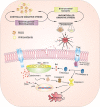The effect of environmental contaminants on testicular function
- PMID: 21706039
- PMCID: PMC3739630
- DOI: 10.1038/aja.2011.40
The effect of environmental contaminants on testicular function
Abstract
Male reproductive health has deteriorated considerably in the last few decades. Nutritional, socioeconomic, lifestyle and environmental factors (among others) have been attributed to compromising male reproductive health. In recent years, a large volume of evidence has accumulated that suggests that the trend of decreasing male fertility (in terms of sperm count, quality and other changes in male reproductive health) might be due to exposure to environmental toxicants. These environmental contaminants can mimic natural oestrogens and target testicular spermatogenesis, steroidogenesis, and the function of both Sertoli and Leydig cells. Most environmental toxicants have been shown to induce reactive oxygen species, thereby causing a state of oxidative stress in various compartments of the testes. However, the molecular mechanism(s) of action of the environmental toxicants on the testis have yet to be elucidated. This review discusses the effects of some of the more commonly used environmental contaminants on testicular function through the induction of oxidative stress and apoptosis.
Figures

Similar articles
-
Role of Oxidative Stress in Male Reproductive Dysfunctions with Reference to Phthalate Compounds.Urol J. 2015 Nov 14;12(5):2304-16. Urol J. 2015. PMID: 26571312 Review.
-
Effect of environmental contaminants on mammalian testis.Curr Mol Pharmacol. 2014;7(2):119-35. doi: 10.2174/1874467208666150126155420. Curr Mol Pharmacol. 2014. PMID: 25620229 Review.
-
Environmental and occupational pesticide exposure and human sperm parameters: A Navigation Guide review.Toxicology. 2022 Jan 15;465:153017. doi: 10.1016/j.tox.2021.153017. Epub 2021 Oct 29. Toxicology. 2022. PMID: 34756984
-
Potential effects of environmental toxicants on sperm quality and potential risk for fertility in humans.Front Endocrinol (Lausanne). 2025 May 21;16:1545593. doi: 10.3389/fendo.2025.1545593. eCollection 2025. Front Endocrinol (Lausanne). 2025. PMID: 40469442 Free PMC article. Review.
-
Environmental contaminants and male infertility: Effects and mechanisms.Andrologia. 2021 Feb;53(1):e13646. doi: 10.1111/and.13646. Epub 2020 May 24. Andrologia. 2021. PMID: 32447772 Review.
Cited by
-
Male reproductive aging: can men with oligospermia become azoospermic over time?Int J Impot Res. 2023 Sep;35(6):505-508. doi: 10.1038/s41443-022-00634-9. Epub 2022 Oct 17. Int J Impot Res. 2023. PMID: 36253473 Review. No abstract available.
-
DEHP exposure destroys blood-testis barrier (BTB) integrity of immature testes through excessive ROS-mediated autophagy.Genes Dis. 2018 Jun 25;5(3):263-274. doi: 10.1016/j.gendis.2018.06.004. eCollection 2018 Sep. Genes Dis. 2018. PMID: 30320191 Free PMC article.
-
Paternal exposures to environmental chemicals and time-to-pregnancy: overview of results from the LIFE study.Andrology. 2016 Jul;4(4):639-47. doi: 10.1111/andr.12171. Epub 2016 Apr 7. Andrology. 2016. PMID: 27061873 Free PMC article.
-
Impact of environmental contaminants on reproductive health of male domestic ruminants: a review.Environ Sci Pollut Res Int. 2020 Feb;27(4):3819-3836. doi: 10.1007/s11356-019-06980-4. Epub 2019 Dec 16. Environ Sci Pollut Res Int. 2020. PMID: 31845245 Review.
-
First study of in vitro protective effect of Lepidium meyenii (Maca) on frozen-thawed bovine spermatozoa.Vet World. 2022 Jun;15(6):1481-1488. doi: 10.14202/vetworld.2022.1481-1488. Epub 2022 Jun 14. Vet World. 2022. PMID: 35993065 Free PMC article.
References
Publication types
MeSH terms
Substances
LinkOut - more resources
Full Text Sources
Medical

